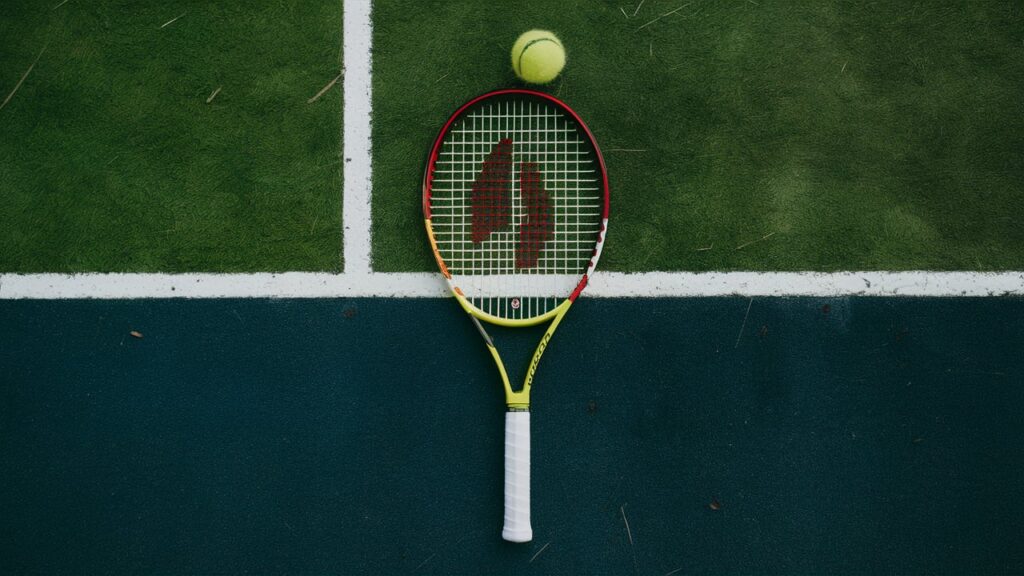Tennis racket handles are essential for a good grip and performance. They are made with precision and care.
Tennis is a popular sport, enjoyed by many around the world. The handle of a tennis racket plays a crucial role in the game. It affects how well you can control the racket and hit the ball. Making a tennis racket handle involves several steps and materials.
Each step ensures that the handle is strong, comfortable, and suited to the player’s needs. In this blog post, we will explore the process of making tennis racket handles. You will learn about the materials used, the design process, and the craftsmanship involved. Stay tuned to discover the fascinating details behind creating the perfect tennis racket handle.
Introduction To Tennis Racket Handles
Tennis is a beloved sport worldwide. The racket is a crucial part of the game. Every part of the racket matters. The handle, in particular, plays a vital role. It connects the player to the racket. Understanding how handles are made is fascinating. It involves science and craftsmanship.
Importance Of The Handle
The handle is the player’s point of contact. A good grip can improve performance. It provides comfort and control. The handle affects the player’s swing. A well-made handle can prevent injuries. It reduces strain during intense matches. Comfort is key for long sessions.
Historical Background
The design of racket handles has evolved. Early rackets had wooden handles. They were simple and less comfortable. Over time, materials improved. Manufacturers introduced leather wraps. This added grip and comfort. Modern handles use advanced materials. Technology has enhanced durability and feel. The evolution reflects the sport’s growth.
Materials Used In Handles
Tennis racket handles are crafted using materials like leather, synthetic grips, and cushioned wraps. These materials provide comfort and better grip for players.
Tennis enthusiasts often focus on the racket’s string tension and frame. Yet, the handle’s material is crucial for performance and comfort. Let’s dive into the materials used in tennis racket handles.
Common Materials
Most tennis racket handles are made from two primary materials: leather and synthetic grips.
Leather handles offer a traditional feel. They provide excellent grip and absorb sweat well. Many professional players prefer leather for its durability and classic touch.
Synthetic grips, on the other hand, are made from polyurethane or other polymers. They are often softer and more cushioned than leather, providing a comfortable hold. These grips can be textured to enhance grip, making them popular among recreational players.
Innovative Alternatives
Recent advancements have introduced alternative materials for racket handles.
Some brands now use recycled materials. This eco-friendly option not only reduces waste but can also offer comparable performance to traditional grips.
Another innovative material is cork. Known for its natural cushioning and lightweight properties, cork handles can improve comfort and reduce fatigue during long matches.
Have you ever wondered if the handle’s material affects your game? It might be worth experimenting with different options to find the perfect match for your playing style.
Design Process
Crafting tennis racket handles involves precise material selection and shaping. Skilled artisans mold each handle for optimal grip and comfort. Various techniques ensure durability while maintaining lightweight structure.
The design process of a tennis racket handle is a fascinating journey. It involves creativity, precision, and a deep understanding of player needs. Let’s dive into the key stages that bring these unique designs to life.
Initial Concepts
Creating a tennis racket handle starts with brainstorming. Designers sketch ideas, considering factors like grip comfort, weight distribution, and aesthetic appeal. They often draw inspiration from existing models while seeking ways to improve them.
Imagine holding a racket that feels like an extension of your arm. This is the goal when designers develop initial concepts. They aim to create handles that enhance your playing experience.
Prototyping
Once concepts are finalized, the next step is prototyping. Designers create physical models to test their ideas. This stage is crucial for identifying potential issues before mass production.
The prototype is where theory meets reality. Holding a prototype in your hand can reveal insights that sketches cannot. Does it feel balanced? Is the grip comfortable for different playing styles?
Testing multiple prototypes helps designers refine their concepts. Sometimes, unexpected challenges arise, prompting innovative solutions. It’s a dynamic process that requires adaptability and keen observation.
The journey from concept to prototype is both exciting and demanding. Each step brings designers closer to crafting the perfect tennis racket handle. Have you ever wondered how much thought goes into the design of something you use every day?
Manufacturing Techniques
Have you ever wondered how the handle of your tennis racket is made? The process involves several interesting techniques. Let’s dive into two main methods: injection molding and handcrafting.
Injection Molding
Injection molding is a common method used in mass production. It ensures consistency and precision. The process starts with melting plastic pellets until they become a thick liquid.
The liquid is then injected into a mold that shapes the handle. Once it cools, the handle is solid and ready for the next step. This technique is efficient and produces handles quickly.
One of the key advantages is uniformity. Every handle comes out identical, which is great for maintaining quality. Have you ever noticed how every handle feels the same in your hand? That’s thanks to injection molding.
Handcrafting
Handcrafting is a more traditional and meticulous approach. Skilled artisans shape each handle by hand, focusing on every detail. This method allows for customization and unique designs.
Artisans often use wood or leather, adding a personal touch to each handle. The process involves cutting, sanding, and finishing the materials. Each handle is a work of art, crafted with care and precision.
Handcrafted handles often have a unique feel. They may not be as uniform as injection molded ones, but they offer a distinct experience. Do you appreciate the craftsmanship in your racket? That’s the beauty of handcrafting.
Both techniques have their advantages. Injection molding is perfect for consistency and speed. Handcrafting offers uniqueness and a personal touch.
Which method resonates with you more? The precision of injection molding or the artistry of handcrafting? Understanding these techniques might change the way you look at your tennis racket handle.
Quality Control
Quality control in the manufacturing of tennis racket handles is crucial to ensure each racket performs at its best and lasts long. This process involves meticulous inspections and testing to meet strict standards. Every handle must pass these checks before it reaches you, the player.
Standards And Testing
Manufacturers follow strict standards to ensure consistency and durability. These standards include the materials used, the dimensions of the handle, and the finishing quality.
Testing involves several stages. Each handle undergoes stress tests to assess its strength and flexibility. This ensures it can withstand intense gameplay without breaking.
Additionally, handles are tested for comfort. Ergonomic tests check if the handle fits well in your hand. A good grip can significantly enhance your game performance.
Common Defects
Despite rigorous quality control, some defects can still occur. One common issue is surface imperfections. These can affect your grip and cause discomfort during play.
Another defect is improper balance. A handle that is not balanced can throw off your swing and affect your accuracy.
Loose fittings can also be a problem. If the handle is not securely attached to the racket, it could lead to breakage during a match. Ensuring a tight fit is essential for safety and performance.
Have you ever noticed a defect in your tennis racket handle? Share your experience in the comments. Your insights can help others make better choices.
Understanding these quality control measures can help you appreciate the craftsmanship behind every tennis racket handle. Next time you play, you’ll know the effort that goes into ensuring your racket is perfect.
Customization Options
Customization is key when it comes to tennis racket handles. It can significantly impact your performance and comfort on the court. By tailoring your racket handle, you can enhance your grip, control, and overall game experience.
Personalized Grips
Personalized grips are a popular customization option. You can choose from a variety of materials like leather, synthetic, or rubber. Each material offers a different feel and level of tackiness.
Some players prefer a thicker grip for added comfort. Others opt for thinner grips to enhance their connection with the racket. Experiment with different sizes to find what suits your style.
Color customization is also available. You can add a pop of color to match your personal taste or team colors. This not only makes your racket unique but also adds a touch of personality.
Professional Preferences
Professional players have specific preferences for their racket handles. Many pros customize their grips to suit their unique playing styles and needs. Some prefer a softer feel, while others go for a firmer grip.
Top players often use overgrips to achieve their desired feel. Overgrips can be easily replaced, allowing them to maintain consistency. This is crucial for players who compete regularly.
Customization is not just for the pros. You can learn from their preferences and apply them to your own game. Have you ever considered what grip Novak Djokovic uses? Finding out can inspire you to try new options.
What customization options do you think would enhance your performance? Share your thoughts in the comments below!
Sustainability In Production
Manufacturers are increasingly focusing on sustainability in tennis racket production. This shift aims to reduce environmental impact while maintaining high-quality equipment. Sustainable practices in production ensure that tennis rackets are made responsibly.
Eco-friendly Materials
Many tennis racket handles now use eco-friendly materials. Bamboo is a popular choice due to its fast growth and strength. Cork is another sustainable option; it is renewable and provides a comfortable grip. Using these materials helps reduce reliance on harmful plastics.
Waste Reduction
Efforts are made to minimize waste during production. Manufacturers are adopting techniques to reuse and recycle materials. This includes repurposing leftover pieces from the handle-making process. Efficient use of resources reduces waste and promotes a greener production cycle.
Innovative designs also play a role in reducing waste. Some companies create handles with fewer components, leading to less material waste. Streamlined production methods ensure that fewer resources are used, benefiting the environment.

Future Trends
Crafting tennis racket handles involves precision and innovation. Manufacturers use advanced materials for durability and comfort. Ergonomic designs enhance grip and performance on the court.
The world of tennis is always evolving. As technology advances, so do the tools players use. Tennis racket handles are no exception. The future holds exciting trends and innovations that will shape this essential part of the game.
Technological Advances
New materials and technologies are transforming racket handles. Researchers are developing lightweight, durable materials. This makes rackets easier to swing and control. Carbon fiber and advanced composites are popular choices. These materials offer strength without added weight.
Smart technology is also making its way into racket handles. Sensors can now track a player’s grip and swing. This data helps players improve their game. It provides insights on grip pressure and handle positioning. This technology is becoming more affordable. Soon, more players will have access to these advanced features.
Market Evolution
The market for tennis racket handles is expanding. Players now have more options than ever. Customizable handles are gaining popularity. Players can adjust the grip size and shape to fit their hand. This ensures comfort and better performance.
Eco-friendly materials are also in demand. Manufacturers are exploring sustainable options. Bamboo and recycled materials are being used. These options appeal to environmentally conscious players.
The market is also seeing growth in hybrid handles. These combine traditional and modern materials. They offer a balance of comfort, control, and durability. Players can choose handles that suit their playing style. The variety ensures everyone finds their perfect match.
As the market evolves, so does the technology behind tennis racket handles. The future promises more advancements. These innovations will help players at all levels improve their game.
Frequently Asked Questions
How Do You Make A Tennis Racket Grip?
Wrap the grip tape around the handle, starting at the base. Secure it tightly and overlap slightly. Finish by trimming the excess tape. Use a finishing tape to secure the end. Ensure it’s comfortable and firm for optimal play.
What Are The 4 Types Of Grips In Tennis?
The four types of grips in tennis are the Eastern grip, Western grip, Continental grip, and Semi-Western grip. These grips influence how players hit the ball and their overall playing style. Each grip has unique advantages for different strokes and shots in tennis.
How Are Tennis Rackets Manufactured?
Tennis rackets are made by layering carbon fiber sheets, molding them into shape, and then baking them. The frame is then drilled, painted, and strung with strings. This process ensures durability and optimal performance.
Why Is Graphite Used In Making Handles For Tennis Racquets?
Graphite is used in tennis racquet handles because it provides lightweight strength, durability, and excellent vibration dampening for better control.
Conclusion
Crafting tennis racket handles involves precision and care. Each handle begins with selecting the right materials. Skilled artisans then shape the handle with expertise. Quality checks ensure durability and comfort. The final product balances grip and control. These handles are essential for a perfect swing.
Understanding their creation enriches appreciation for the sport. Next time you play, remember the effort behind your racket handle. Consider how craftsmanship impacts your performance. Enjoy the game with this new insight.








